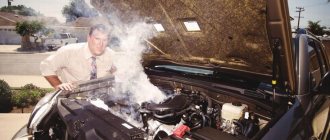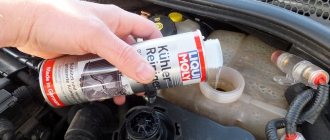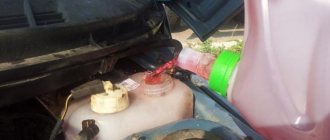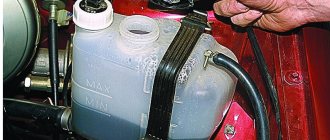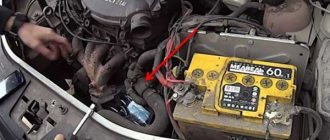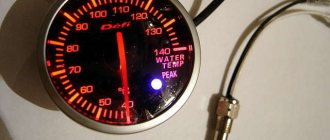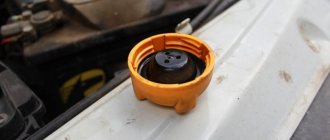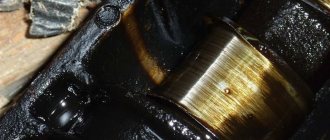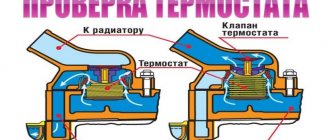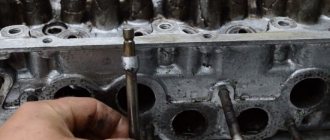How to check the antifreeze level correctly - “cold” or “hot”?
Checking the coolant level should be done regularly, but not all car owners pay enough attention to this procedure. Such actions can cause serious malfunctions
, including complete engine failure. Today we will take a closer look at this issue and talk about the features of checking the antifreeze level on modern cars.
Will the article be useful? Don't forget to give a "thumbs up"
and
subscribe to the channel
!
If we can find out about low engine oil level, thanks to readings from the built-in sensor
, then the engine cooling system very rarely has such a device.
As a result, motorists can drive for a long time without knowing about a possible problem
. At the same time, the malfunction can remain hidden for a very long time, since antifreeze can leave the system slowly.
Often, coolant “leaks” through leaky joints or damage in the pipes or
radiator
.
However, many car enthusiasts also encounter a defective cylinder head gasket. This phenomenon results in antifreeze getting into the engine oil
.
As a result, the metal elements of the engine do not receive sufficient lubrication, and a car with such a malfunction cannot
. This is why it is important to regularly check the coolant level in the system.
In practice, I have often met car enthusiasts who check the antifreeze level “while it’s hot,” that is, immediately after a long trip. This approach can lead to a number of negative consequences.
.
Firstly, you cannot open the expansion tank with heated coolant. Otherwise, you can damage your hands with hot antifreeze, which will leave severe burns. But it’s also not worth checking the fluid level without removing the cap on a warm engine. Some antifreeze is still in the system, so the readings will be incorrect
.
Correctly monitor the coolant level after a long stay, preferably in the morning. In this case, the engine will completely cool down, and all the coolant will end up in the expansion tank
.
It is worth noting that auto mechanics recommend sticking to the average
between the maximum and minimum marks. Too much antifreeze in the system negatively affects cooling efficiency and pump life.
If the coolant consumption is high, you should contact a service center to find out the cause of the malfunction.
.
The main symptom of a broken cylinder head gasket is sweetish white smoke from the exhaust pipe
. If it appears, you should stop using the car until a full repair is carried out.
Source
What affects the degree of filling of the tank with antifreeze
The antifreeze level is affected by:
- integrity of the cylinder block, cylinder head, cylinder head gasket, radiator, hoses, tubes, heater and expansion tank;
- correct fixation of hoses with clamps;
- normal operation of the expansion tank and radiator cap valves;
- the condition of the outlet from the neck and the hose connecting it to the expansion tank;
- fuel system operation;
- setting and operation of the ignition system;
- type of antifreeze;
- driving style.
If there are cracks in the cylinder block or cylinder head or the cylinder head gasket is broken, then the coolant will constantly leak either into the oil or into the cylinders. In the first case, the oil will begin to turn into a bubbly suspension, in the second, the exhaust from the engine will look like white steam even in warm weather. If the cylinder head gasket is broken, then both of the symptoms described above are possible.
In addition, there will be a noticeable decrease in engine power and vehicle response, as well as an increase in fuel consumption. If the hoses are loosely secured with clamps, then when the engine warms up, when the pressure in the cooling system increases, antifreeze will begin to flow through them.
If the radiator and expansion tank valves are faulty, the pressure in the system will not be able to rise to the required level. As a result, the boiling point of the antifreeze will decrease and there is a risk of vapor locks forming, which will lead to serious damage to the cylinder head. If the neck outlet or hose to the expansion tank is clogged, the coolant will not be able to return to the radiator, and from it to the engine. As a result, the level will drop and there is a risk of vapor locks forming.
Heating of the cylinders depends not only on the operation of the cooling system, but also on the serviceability and settings of the fuel equipment and ignition system. If the fuel system supplies a lean air-fuel mixture, it will detonate, burning much faster and generating more heat.
This will lead to an increase in the temperature of the coolant, the formation of vapor locks and boiling. As a result, a drop in antifreeze level, overheating of the engine and the need for expensive repairs. If the mixture is over-enriched, then to ensure normal engine power you will have to press the gas pedal harder. As a result, the cylinders will be filled with an increased amount of fuel, which will lead to an increase in temperature, a drop in the antifreeze level and boiling.
Glycerin-based antifreezes boil at temperatures of 90-100 degrees, so even a slight overheating of the engine will lead to the formation of steam. If the driver prefers to drive in high gears and low engine speeds (below 2 thousand per minute), then any hill will increase the load on the engine and increase its temperature. After all, at such engine speeds, the pump will not be able to provide the required flow of antifreeze. As a result, the cylinder head will begin to overheat, the liquid will begin to emit steam and its level will gradually decrease.
The need to check the coolant
How often should antifreeze be checked? It depends on what kind of car you have, how old it is and what its general technical condition is. If you do not check how much fluid is in the tank and do not top it up in a timely manner, engine problems are inevitable. During operation, the motor constantly heats up, especially in hot weather, and for normal operation it needs regular cooling.
The service life of your car's engine directly depends on the condition of the coolant.
Why you need to regularly monitor this process:
- antifreeze cools the engine, preventing it from overloading and breakdowns;
- its composition, circulating through a closed system, “extends the life” of the engine;
- external fluid leakage can lead to contaminated vehicle surfaces that are difficult to remove;
- internal leaks are dangerous: if antifreeze gets into the cylinders, this can cause water hammer and complete failure of the car engine.
Any antifreeze is a liquid with a characteristic odor and color. Thanks to its special chemical composition, it does not turn into ice at low temperatures and remains in the same state in any weather conditions.
Probable leak locations
Where can antifreeze go? It is still a liquid, so it can evaporate when heated. To make evaporation less intense, the tank or radiator is tightly closed with a lid. But complete blockage is also not allowed, so there are bypass valves in the lid.
Read more: Chevrolet Niva VAZ 2123 photos
They are needed to relieve pressure in the system if it has risen above the critical norm. It is through this valve that antifreeze evaporates, especially in the summer season. It is very hot in the summer, and if you drive in a traffic jam, the cooling system will not have time to fully remove heat from the engine; it will operate at an elevated temperature. In this case, the antifreeze heats up more than normal, part of it goes into a gaseous state (steam), increasing the pressure in the system, and when the pressure rises above normal, the steam will be released through the valve.
Antifreeze may also leak due to a leak in the system or a crack in one of the rubber pipes. Because of this, the coolant will simply leak out through a leak or crack. In this case, it is very easy to detect a leak - by drips on the pipes and traces of liquid on the asphalt under the car while parked.
The most unpleasant leak is due to a breakdown of the cylinder head gasket (cylinder head). As a result of the breakdown, the cooling system channel is connected to the cylinder, or the crack leads outward. It is very dangerous if a breakdown connects the channel to the cylinder. Not only will the liquid “fly out into the pipe” in the literal sense, but if the repair is untimely, a “water hammer” may occur due to the large amount of antifreeze in the cylinder, and this is already fraught with serious problems, since as a result of this effect the destruction of the piston is possible, connecting rod bend.
It is noteworthy that a cylinder head gasket failure is usually a consequence of engine overheating due to insufficient antifreeze.
Errors when handling antifreeze and their consequences
When checking the antifreeze level in the tank, it often becomes necessary to top it up. In winter, it evaporates intensely, so you need to check its condition more often at this time. At low temperatures, all elements of the expansion tank partially lose their tightness, as the properties of rubber and plastic change. This is fraught with antifreeze leaks. As a rule, they are not fatal, but this does not eliminate the need to monitor the process and timely add a new portion of antifreeze.
Typical mistakes when handling antifreeze are:
- the plug is unscrewed “hot”, without waiting for the engine to cool down;
- there is no rag on the tank (if the tank has not had time to cool completely, this can be dangerous);
- fresh liquid is added “to the hot one;
- antifreeze is poured into an empty container;
- do not use distilled water, but ordinary water when topping up.
No matter what frivolous “experienced” drivers say, you cannot unscrew the cap when the engine is hot. Even if the brave souls are constantly lucky, it is not a fact that next time everything will be exactly the same. Since the pressure in a closed system is high, when you unscrew the cap “hot,” the liquid may splash out onto your hands or even onto your face. Serious burns always leave scars, so there is no need to rush and tempt fate.
There are situations when there is no time to wait until the system has completely cooled down. In this case, place a rag over the lid before unscrewing. It will close the drain hole and prevent a strong splash of antifreeze, but will not be able to protect against splashes. To avoid injury, it is better, however, to wait until the engine has completely cooled down and only then get to work.
The fluid level in the expansion tank cannot be checked “hot”. Never add new antifreeze until the system has completely cooled down. Remember that when warming up, there is a risk of overfilling the maximum level, squeezing antifreeze into the space under the hood of the car and damaging its internal parts.
The tank should not be allowed to become completely empty. When adding antifreeze to an empty container, air may enter the system along with it. The engine will overheat and fail. If the tank still turns out to be empty, fresh antifreeze must be filled at a service station.
You may also be interested
Can antifreeze freeze?
With the onset of cold weather, many drivers are faced with an unexpected phenomenon: antifreeze freezes in the expansion tank of the cooling system. In such a situation, questions arise as to why this happened and how to prevent a similar situation from reoccurring in the future. Our experts will help answer these questions.
Sintec Multifreeze - one for all
Modern technologies make our lives easier. Think back to cell phones from the early 2000s: most of them had their own connectors and original chargers. But then manufacturers came to a single universal solution in the form of microUSB, which significantly simplified the operation of smartphones. There are similar examples in the automotive industry. Do you know how to choose the right antifreeze for topping up? Some are guided [...]
Checking the tightness of the plug and tank
As a result of shaking and constant movement, the valve can rust - as a result of constant contact with the liquid. To prevent leaks, you need to regularly check what condition it is in. Like topping up, checking the plug should be done only after the engine has completely cooled. The valve is inspected and screwed back in. If it does not tighten well, it should be changed.
You can check the tightness of the container using a stand. Usually, this is done at service stations, but if you wish, you can organize such a test yourself. The tank is carefully removed from the car. It has three holes. Two of them are turned off, and the remaining one is supplied with air by a pump to inflate the tires. The plug should be tightly screwed during testing. If, when creating high pressure inside the container, the valve allows air to pass through, it must be urgently changed.
If the valve maintains a pressure of 1.3 to 2 atmospheres, it is also inoperative. The optimal indicator of the good condition of the plug is when, at a pressure of 1.4 atmospheres or more, it opens and releases excess pressure.
After disconnecting the pump, the pressure in the tank must be maintained: this ensures that the tank is in order and ready for further use.
How to check the coolant level
Checking the liquid level is carried out following the following algorithm:
- wait until the engine cools down completely;
- remove the radiator cap and inspect the outlet hose;
- the liquid should be at the level of the lower edge of the outlet hose;
- There are two marks in the tank: min and max. Ideally, antifreeze is located between them.
If the amount of antifreeze is small, you need to top it up, start the engine and warm it up to operating condition (90-95C). After warming up, the engine must be cooled. If after this there is much less liquid in the container, the tightness of the cooling system is broken, and this problem must be eliminated. When the fluid remains at the same level after this simple check, there is nothing to worry about.
Cooling systems vary from car to car. If the container is made of transparent or light plastic, it is easy to monitor the antifreeze level. Since it has a specific bright color, it is always visible in a light tank. If there are min and max marks, the cap does not need to be unscrewed, because the antifreeze is always visible to the driver. However, there are cars that do not have an expansion tank. In such models, antifreeze must be added through the neck hole. It is located on the radiator. Unscrew the radiator cap, carefully look inside and see what the antifreeze level is inside.
Let's summarize the general rules:
- the rate of antifreeze in the tank is between the maximum and minimum marks;
- no minimum level should be allowed;
- Do not overfill antifreeze, otherwise it will splash out under high pressure.
How to properly add coolant to the expansion tank
First of all, you need to make sure that the car is on level ground. Only the same composition that is in the system should be added. Not all antifreezes allow mixing.
The engine is allowed to cool, after which the expansion tank cap is removed and fresh fluid is added. Distilled water can be used in small quantities if there is confidence in the tightness of the system, that is, the consumption was due to evaporation and not leakage.
After adding fluid to the normal level, the engine must be warmed up, preferably with a test drive, to operating temperature, and then cooled again. It is quite possible that air pockets will leave the system and fluid will have to be added.
What can be added and in what quantity?
There are several types of antifreeze. You cannot mix them with each other, but you must add them strictly according to the marks. There is an opinion among car enthusiasts that some types of coolants are compatible with each other in terms of their chemical composition, but it’s still not worth taking risks and mixing them. To avoid unpleasant situations and machine breakdowns, use one type of fluid and buy it from trusted manufacturers.
When adding any water (regular or distilled), antifreeze may freeze in winter. If there is no fresh portion of antifreeze, add water only in the warm season. Never dilute the coolant with other chemicals. As a last resort, use plain water, but do not overuse it.
The lack of antifreeze in the tank can take the driver by surprise before the winter cold. To prevent this from happening, before the winter season, completely change the cooler and fill in a new one.
You need to spend time monitoring the condition of the coolant, otherwise it can be fraught with bad consequences for the car. If you check the antifreeze level in a timely manner, the engine will work properly, and the car will serve you for many years.
Source
What should be the level of antifreeze: standard and details of testing
Issues discussed in the material:
- Why check the antifreeze level?
- What level of antifreeze should be in the expansion tank?
- What should the antifreeze level be for “cold” and “hot”
- What level of antifreeze should be in the radiator
- Valuable tips for using antifreeze
- Car owners' opinions on checking antifreeze levels
If you want to know what the antifreeze level should be, then most likely your car's engine is running low on coolant. Often, inexperienced drivers do not pay any attention to antifreeze and do not check its level.
But it is precisely for this reason that serious problems can occur in the future, because this liquid is intended for the engine - the heart of any car. You can avoid such problems by monitoring the fluid level from time to time, the optimal level of which we will discuss later.
Why do you need to check antifreeze?
It is recommended to check the car's coolant level twice a year - before the start of the summer and winter seasons. But this recommendation is somewhat incorrect, because the cooling system performs a very important function - maintaining the optimal temperature regime of the power plant. If there is not enough antifreeze, this is fraught with very serious problems. Therefore, it is better to check the coolant level every time you open the hood of the car, since this operation is simple and takes a couple of minutes.
Checking the level every time the owner looks into the engine compartment almost completely eliminates missing the moment when there is not enough antifreeze in the system. A reason to check the fluid level in the cooling system may also be an increased engine temperature while driving.
Why check the antifreeze level?
What should the antifreeze level be and how often should I check it? The answer to this question depends on the make and model of the car, any existing faults, and whether the car is new or not. In any case, the driver should not treat his car negligently. If you do not monitor the fluid level, the motor will quickly fail. The fact is that the temperature of a running engine rises greatly, especially in the summer. And in order for the power unit to function properly, the level of antifreeze must be optimal.
Please note : if you want the engine to last a long time, the antifreeze must be in perfect condition.
You should know what the antifreeze level should be because:
- the coolant prevents the power unit from overheating, which means the engine will work properly, without overload;
- antifreeze, moving through a closed system, increases the life of the engine;
- if a coolant leak occurs, it will not be easy to wash the surface of the car;
- If an internal leak occurs when antifreeze enters the cylinders, a water hammer may occur, after which the machine will stop working.
Coolant has a specific smell and a certain shade. Due to the special chemical components included in the antifreeze, it remains in a liquid state even at sub-zero temperatures. His physical condition does not change, no matter how hot or cold it is outside.
What does antifreeze affect?
Interestingly, the engine cooling solution expands like any other liquid. Its excess is sent to the expansion tank, which can be found under the hood. This process allows you to maintain the balance necessary for the normal operation of the power unit. The tank itself has special marks, and this is for a reason. Both a lack and an excess of coolant are equally dangerous for a car. For example, during the movement of antifreeze, the risk of formation of vapor locks, which can damage the engine, is reduced. If there is a lack of refrigerant, the engine overheats greatly, and this can disrupt the temperature regime of the cylinder head. In turn, the oil channels may collapse, and fuel consumption will probably creep up. The result may be “capital”. That is why it is necessary to ensure that the optimal level of antifreeze in the expansion tank is maintained.
What is antifreeze?
An attentive car enthusiast will probably notice that the coolant can have different colors, for example, red or green. The logical question is: is it possible to mix products with different shades? The answer is obvious - in no case, because this can significantly reduce the effectiveness of the final mixture. It is worth understanding that color is the result of adding dye. The main components have a completely different meaning. For example, most antifreeze is propylene or ethylene glycol (approximately 95%). The remainder is taken up by water and numerous additives. Perhaps the most important of them are corrosion inhibitors, which protect the unit itself and its elements from rust.
You may be interested in: SINTEC oils - confidence in the future
What level of antifreeze should be in the expansion tank?
When the lubricant level in the engine is insufficient, an indicator should appear on the dashboard to warn the driver of this problem. However, the cooling system most often is not equipped with special sensors. Therefore, determining that the antifreeze level should be higher can be difficult. The car owner continues to operate the vehicle, not realizing that there is not enough antifreeze. After all, coolant can leak out little by little over a long period of time.
There are often cases when the antifreeze level is insufficient because there is a leak through a leaky joint, damaged pipes or radiator. In addition, the cause of this problem may be a defective cylinder head gasket. As a result, the antifreeze mixes with the oil in the engine. All this leads to the fact that the engine parts will be poorly lubricated. It is clear that operating a car in such a situation will end in its breakdown. For this reason, it is important to know what the antifreeze level should be and check it periodically.
How to find out the level of antifreeze that should be? To do this, you need to inspect the expansion tank into which antifreeze is poured. The tank will have the following inscriptions: “Min” and “Max”. The optimal level of antifreeze should be such that it reaches the middle of the distance between the minimum and maximum values.
However, it also happens that the inscriptions are missing. What should the antifreeze level be in this case? Carry out a visual inspection; the antifreeze in the tank should be 50% of its volume. When it is not possible to determine the antifreeze level in this way, you should measure the depth of the tank. To do this you need to use a clean stick. Then, if necessary, you should add antifreeze, focusing on the fact that its level should be up to half the tank.
Important : You can only use antifreeze recommended by the car manufacturer. When you add coolant, it should match the markings and shade of what is already in the reservoir.
The antifreeze level should not be less than that on the expansion tank. Also, you should not overfill antifreeze above normal. In both the first and second cases, the machine will not work properly.
- The antifreeze level is below normal . As a result, the small circle will not be filled. All this will lead to the motor overheating and operating at elevated temperatures. In the best case, the car will begin to consume more fuel, and the channels and tubes will crack. In the worst case, the life of the motor will be sharply reduced, it will fail ahead of time, it will simply jam. The same thing should happen if you operate the car without antifreeze at all.
- The antifreeze level is higher than normal . Of course, some car owners believe that if they add a little more antifreeze than normal, this will save them from adding coolant in the future. However, do not forget that after heating, antifreeze expands. As a result, if its volume is greater than permissible, the pressure in the system will increase. This will lead to the tank cap being ripped off and the system depressurizing. A leak will appear, and then the antifreeze will simply pour out of the tank. If the antifreeze level is too low, the engine will fail.
We recommend
Every driver should check the antifreeze level regularly; it is recommended to do this every 7 days. This is the only way to keep the engine in good condition and detect a leak or depressurization of the cooling system in time.
note
: Since antifreeze is a liquid, it should evaporate over time. After all, the system cannot be 100% sealed. Therefore, the antifreeze level will gradually drop. Antifreeze boils at a temperature of 120 °C. If the cooling system is faulty, you may notice clouds of steam coming from the engine compartment. This indicates that the car owner must be prepared for the costs of major engine repairs.
Coolant: antifreeze level
The engine cooling system is closed and completely sealed. In this case, the level of antifreeze plays a vital role in the system, since an insufficient level of antifreeze or antifreeze will lead to overheating of the engine. In turn, strong overflow can cause leaks, rupture of pipes or expansion tank.
- For this reason, it is important to maintain optimal antifreeze levels. The volume of liquid is determined using an expansion tank, into which coolant is poured when filling the system. As a rule, there are “min” and “max” inscriptions on the tank, indicating the minimum and maximum fluid levels in the cooling tank.
- The norm is considered to be when the system is filled with high-quality ready-made antifreeze, the level of which is between the indicated marks. If there are no marks, then the middle of the tank is considered the norm (you can measure the total depth of the tank with a ruler).
- It is important to take into account that the level of antifreeze changes during heating and cooling. For this reason, you need to remember that the “cold” coolant level and the “hot” coolant level will be different.
In practice, if you fill the cold tank almost to the maximum, after warming up the liquid level will exceed the norm. Also, if you pour to a minimum (adjusted for heating), after warming up the liquid may not be enough for the entire system to operate most efficiently. This means that during operation it is advisable to determine how much the level rises when hot on a particular car.
Taking into account the fact that often when fully warmed up, the liquid in the tank rises from the average level closer to the maximum, experienced drivers add antifreeze to the cold one so that its level is slightly below the average level. Subsequently, after warming up, the level rises and will remain above average, but not exceed the maximum permissible.
What should the antifreeze level be for “cold” and “hot”
Many motorists, in order to find out the level of antifreeze, perform diagnostics immediately after a long trip, while the engine has not yet cooled down. However, you shouldn't do that. The fact is that there is hot antifreeze in the expansion tank. If you open it, you can get burned, because the liquid heated to a high temperature under pressure will splash out. However, there is also no need to check how much coolant is in the tank with the cap closed. After all, a little antifreeze circulates through the system, which means the data obtained will be biased.
To find out what the normal level of antifreeze should be, you should check it after the car has cooled down, for example in the morning. Only in this case will the antifreeze completely drain into the expansion tank. Experienced experts say that the antifreeze level should be average (the mark is located between “Min” and “Max”). When the volume of antifreeze is too large, the engine will not cool properly, and the pump will quickly fail.
Knowing what the volume of coolant should be, you can notice that antifreeze is consumed too quickly. In this case, it is recommended to visit a car service center to have the car diagnosed. If the cylinder head gasket is blown, whitish smoke should come out of the exhaust pipe. If you notice this sign, you should stop driving, call a tow truck and take the car to a service station.
How much antifreeze should there be?
If you check the tank, then the optimal level will be between the “Min” and “Max” marks. If the fluid is at the “Min” level or below, the power plant will not have enough fluid even after heating and expansion. Air may be sucked into the system, which, after heating, will only increase the pressure in the system, causing the engine temperature to be elevated and possibly squeezing out the liquid from the reservoir or causing one of the system pipes to break off. But if the level is at “Max” or higher, then after heating the excess antifreeze will simply flow out of the tank.
In those cars where antifreeze is poured into the radiator, there is also a mark on the neck, but this only indicates the normal level. It is usually located at the bottom of the neck. This is where you need to navigate.
A low level of liquid in the cooling system carries the risk of: increased temperature of the power plant and its overheating, increased pressure in the system when heated, and the possibility of splashing due to air entering the system.
What level of antifreeze should be in the radiator
The main mechanism of the cooling system is the radiator. In addition to this, this also includes a fan, water pump, thermostat, hoses, belts, sensors. The coordinated operation of the cooling system allows antifreeze to be directed around the cylinder head and valves. The coolant must pick up thermal energy and return it to the radiator, where it is dissipated. That is why it is necessary to know what the level of antifreeze in the radiator should be. After all, if there is not enough antifreeze, you should add the missing volume as soon as possible.
What should be the level of antifreeze in the radiator and how to determine it?
- Park the car on level asphalt.
It is best to check after traveling a short distance. Without waiting until the engine has completely cooled down, check the antifreeze level. If the car has been driven long enough, you should wait 2-3 hours for it to cool down.
You cannot check the antifreeze level if the engine is not turned off. You should not perform diagnostics if the engine has not yet cooled down.
- Open the hood.
- Inspect the radiator cap.
It should be at the top of the radiator under pressure. If the car is new, you will notice the cap will be marked. Otherwise, you must study the car's owner's manual to find the cap.We recommend
The fact is that antifreeze takes thermal energy from the engine, and part of it is transferred to the radiator and covers. The fabric will protect your hands so you don't get burned.
Check the antifreeze level.
What should the antifreeze level be? Ideally, the mark should be in the top position. When there is an antifreeze level marking on the radiator, this will help you better navigate.
Final valuable tips for using antifreeze
Once you know what the antifreeze level should be, you may find that you need to add more. After all, in the winter season, antifreeze evaporates a lot. This means that inspections should be carried out frequently in winter. If it’s cold outside, the parts of the expansion tank are no longer sealed, because the rubber and plastic elements change their properties. As a result, antifreeze leaks occur. Of course, nothing bad will happen. However, every driver is required to know what the coolant level should be and monitor it. And, if necessary, coolant should be added.
How to check what the antifreeze level should be and avoid mistakes:
You should put a cloth on the tank, otherwise you can get burned if it has not cooled down completely;
Many motorists who are careless about repair work unscrew the cover while it is “hot”. Of course, if you are lucky, nothing bad will happen. However, doing so may result in serious burns. After all, there is high pressure inside the system. And if you remove the plug when the engine has not yet cooled down, antifreeze will splash onto the skin of your hands and face under high pressure. After the burns heal, scars may remain on the skin. You shouldn't risk your health trying to save time.
We recommend
What if you urgently need to check the antifreeze level, but the engine is still hot? Then, before unscrewing it, you should throw a cloth over the lid. It will cover the drain hole and prevent hot liquid from splashing onto the skin. However, if you have the opportunity to wait until the car cools down, you should only perform the cold test.
You cannot check the antifreeze level in the expansion tank until it has completely cooled down. If the system is hot, you should not add new coolant. After all, in this case you can pour antifreeze. It will simply be squeezed out into the engine compartment, which means the car parts will be damaged.
Please note : the antifreeze level must be such that the tank never becomes empty. After all, if you pour coolant into an empty tank, air will get inside along with the liquid. As a result, the power unit will overheat and it will no longer be possible to avoid its breakdown. What to do if the tank is empty? In this case, it is recommended to fill in antifreeze at a car service center, where a specialist will perform this procedure correctly.
If you study the instructions for using coolant, it will be indicated that when it is not possible to use antifreeze, you can fill in purified water. In extreme cases, plain water will do. However, as soon as you can get to a car service center, you should immediately replace the water with antifreeze.
Why shouldn't car owners use water instead of antifreeze? The fact is that its composition contains too large a percentage of mineral salts. As a result, plaque and rust form on the walls of the motor and other parts.
How to check antifreeze for freezing?
There are several ways to determine the freezing point of coolant. Let's look at each of them in detail.
First way
To check the coolant freezing point you will need:
- thermometer;
- pharmaceutical syringe;
- cup.
Let's get started:
- Using a syringe, pump out about 100 grams of coolant from the expansion tank or packaging.
- Pour it into a glass and place it in the freezer. Place a thermometer there along with the consumables.
- Every 3-5 minutes you need to check visually when the coolant begins to become cloudy. At this moment, it is time for crystallization to begin.
- At the moment when the consumable begins to become cloudy, check the coolant temperature with a thermometer.
Second way
Device for measuring density hydrometer disassembled
The idea is that you need to measure the density of the consumable using a special device and calculate the temperature at which crystallization begins using a table. A hydrometer can be purchased at any automotive store. The correspondence table is provided below. The test should be carried out in a room with a temperature of 20 degrees Celsius. Wait some time until your consumables reach this temperature.
- Open the cap of your vehicle's expansion tank.
- Take a hydrometer and collect some coolant in it. To do this, lower the pipette into the expansion tank and, using the so-called “bulb”, take out enough coolant so that the float of the device floats freely in it.
- You need to visually determine the coolant concentration using the hydrometer scale.
- Compare the resulting figure with the table below.
| Propylene glycol solution | Beginning of coolant crystallization | Density at 20˚C | Ethylene glycol solution | Freezing point | Density at 20˚С |
| 30% | -13˚С | 1,023 | 30% | -15˚С | 1,038 |
| 35% | -20˚С | 1,028 | 35% | -20˚С | 1,045 |
| 40% | -25˚С | 1,032 | 40% | -25˚С | 1,052 |
| 45% | -30˚С | 1,035 | 45% | -30˚С | 1,058 |
| 50% | -35˚С | 1,038 | 50% | -35˚С | 1,064 |
| 55% | -45˚С | 1,040 | 55% | -43˚С | 1,071 |
| 60% | -55˚С | 1,042 | 60% | -50˚С | 1,077 |
| 65% | -60˚С | 1,043 | 65% | -60˚С | 1,083 |
| 70% | -65˚С | 1,044 | 70% | -70˚С | 1,088 |
Remember that all the properties and characteristics of the consumable material are indicated on the canister label. So take a few minutes to familiarize yourself with them so that you don't have any questions later.
Also take time to choose the coolant. Do not buy consumables from untrusted suppliers, dubious car markets or from dealers who stand on the side of the road. Often such sellers sell low-quality coolant, the use of which will not lead to anything good.
Also consider your engine specification. Sometimes antifreeze may simply not suit the characteristics of the engine or cooling system. The requirements of the motor should be taken into account as this is a very important point. It is especially not recommended to fill foreign-made cars with Russian antifreeze. Of course, the technology for its production is being modernized, but initially such consumables were designed for domestic cars.
Opinions of car owners about checking antifreeze levels
- Need to check when cold
“To find out what the level of antifreeze should be, we perform the test on a cooled engine. By the way, you also need to fill in fresh coolant “on a cold one.” After all, the tank is designed for the maximum volume plus the amount of antifreeze squeezed out of the engine with a normally functioning cooling system.”
Apparently, all the air was expelled
“I’ll tell you about my experience. I replaced the burst tubes of the rear heater, and also filled in a new coolant. Then I had to top it up a couple of times, because when the car cooled down the tank was empty. Over time, everything returned to normal, the air just left the system.”
The “hot” level is just space, and the cold level is less
“I had a lot of cars. The level of antifreeze “on a hot day” should be higher, “on a cold day” there will always be not enough antifreeze.”
